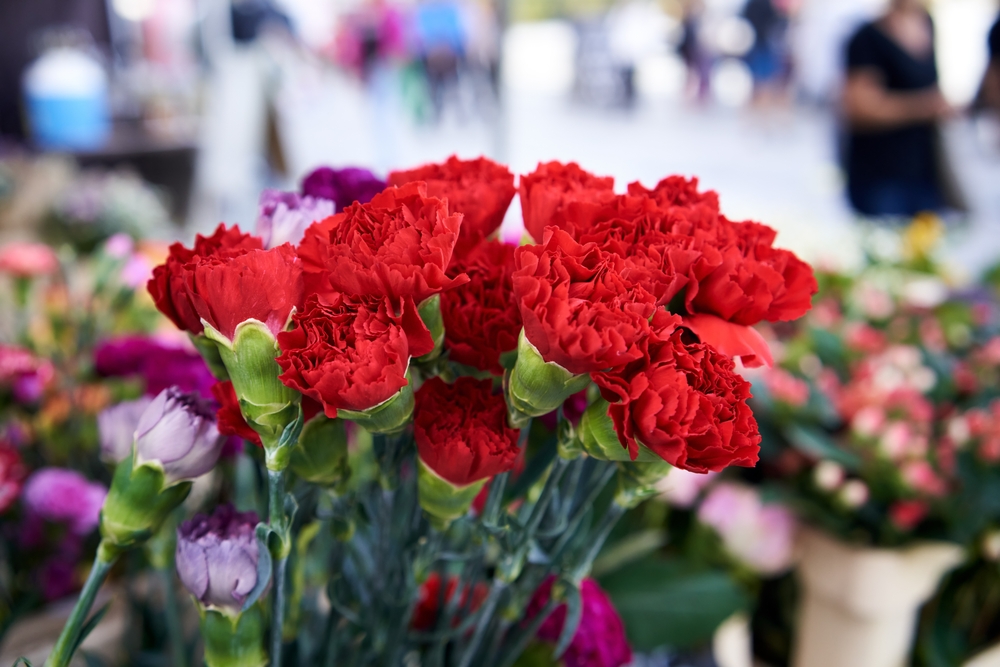The Ohio state flower may take the cake when it comes to state pride. Known for its frilly petals, long vase life, and vibrant color, the red carnation (Dianthus caryophyllus) has been tied to Ohio’s political and cultural identity for more than a century. Its story is rooted in history and tribute, making it far more than just a beautiful bloom.
This connection between a beloved president and his favorite flower laid the groundwork for the red carnation’s eventual status as the Ohio state flower. For those looking to discover more state-inspired blooms, check out our full list of state flowers to explore the symbols representing all 50 states.
Why the Red Carnation was Chosen as Ohio’s State Flower
The red carnation had its official designation as Ohio’s state flower in 1904, just three years after President McKinley’s death. An Ohio native, McKinley was known for always wearing a red carnation in his lapel, considering it a good luck charm. The Ohio General Assembly chose the flower specifically to honor the 25th president and Ohio native.
While other states have chosen native flora to represent them, Ohio made its choice based on values of patriotism, leadership, and remembrance. The flower has since become a timeless emblem in Ohio celebrations and educational traditions.
Five Red Carnation Fun Facts
- Unlike many other state flowers, the red carnation isn’t native to Ohio. It’s a cultivated variety of Dianthus caryophyllus, originally from the Mediterranean region, but its symbolic value made it a fitting state emblem.
- The city of Alliance, Ohio, is known as the “Carnation City” and hosts an annual Carnation Festival every August. The celebration honors both the flower and President McKinley’s legacy with parades, pageants, and community events.
- In the language of flowers, red carnations symbolize admiration, deep love, and affection, making them a meaningful choice for a flower that commemorates a respected national leader.
- Red carnations are prized in bouquets for their longevity. With proper care, they can last up to three weeks as cut flowers, making them one of the longest-lasting blooms available. Check out our flower delivery service to send red carnations straight to someone’s doorstep.
- While red is the official color associated with Ohio, carnations naturally bloom in a variety of other shades, including white, pink, yellow, and striped patterns, each of which has its own symbolic meaning.
Growing and Care Information for Red Carnations
Soil Preparation and Planting Tips
The Ohio state flower thrive in spots that receive plenty of sunlight. They need at least 4–6 hours of direct sun each day to develop strong stems and produce consistent blooms. Look for a well-draining area, as carnations don’t do well with soggy roots.
Carnations prefer neutral to slightly alkaline soil (pH 6.7–7.2) that’s light and well-drained. Heavy or clay-rich soils should be amended with compost, sand, or perlite to improve drainage. Plant red carnations about 12–18 inches apart to allow for airflow, which helps prevent fungal issues.
When to Plant:
- In zones with mild winters (USDA zones 6–9), carnations can be planted in early spring after the last frost.
- In colder areas, start seeds indoors 6–8 weeks before the final frost, then transplant once the soil has warmed.
Watering and Feeding
Red carnations need moderate watering. Allow the top inch of soil to dry out before watering again. Overwatering can lead to root rot, especially in poorly draining soil.
For best results, apply a balanced fertilizer (such as 10-10-10) once a month during the growing season. Avoid fertilizers high in nitrogen, as they can lead to excessive leafy growth at the expense of flowers.
Pruning and Deadheading
To encourage continuous blooming, deadhead wilted flowers regularly by snipping them just above a set of leaves. This redirects the plant’s energy toward producing new buds.
In the fall, cut back stems to 1–2 inches above the soil after the first frost if you’re in a colder climate. In warmer regions, carnations may act as short-lived perennials and can be pruned lightly for shape.
Avoiding Pest and Disease
Carnations are relatively low-maintenance, but they can be susceptible to Aphids and spider mites and fungal diseases. These pests can be sprayed off with water or treated with insecticidal soap. As for fungal diseases like rust or crown rot, avoid overhead watering and make sure plants have good airflow.Remove any infected foliage and avoid working with plants when they’re wet.
Indoor and Container Growing Tips
Red carnations do well in containers, making them perfect for patios or sunny windowsills. Use a light potting mix, and ensure containers have excellent drainage. Rotate pots every few days so plants grow evenly, and pinch back growth to keep the plant bushy.
Learn More State Flowers with The Bouqs
The red carnation is far more than the state flower of Ohio — it’s a blooming tribute to leadership, history, and the spirit of a state that wears its colors with pride. Whether growing them in the garden or giving them in a bouquet, red carnations carry a legacy that continues to blossom with each passing year.
Want to expand your floral knowledge beyond Ohio? You can also learn about the Nevada state flower, which carries its own unique symbolism and story.
Shop All



